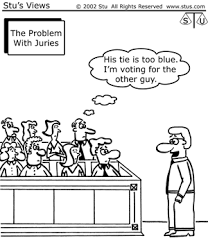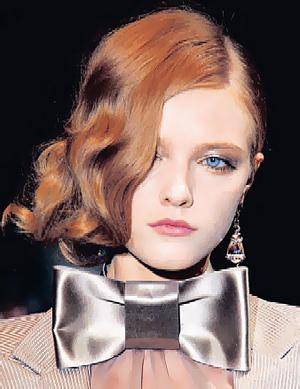April 15, 2011
by Angela N. Johnson

This article reports on an experiment conducted at a program sponsored by the ABA’s Woman Advocate Committee entitled “He Said/She Said: Jurors’ Perceptions of Women Advocates.” The program was designed to test the reactions of male and female mock jurors during two 10 minute closing arguments, both made by women attorneys using contrasting presentation styles (one aggressive, the other more fact specific). The results were analyzed based on the jurors deliberations and careful post-experiment questioning.
Interestingly, the survey revealed that male jurors liked the aggressive approach. Some of the women, on the other hand, viewed the aggressive approach as “scary.” Women jurors also commented on the clothing worn by the presenters, stating they found a mid-calf length skirt with a side slit slightly above the knee and a silk blazer with a high sheen “distracting” (Mahoney 1999).
After the experiment, jury trial experts spoke on establishing credibility. While the statements given did not seem empirically tested, they are worth considering. For example, one panelist said that jurors typically view male attorneys as more competent but that a female litigator who demonstrates her competence is viewed as having more credibility. One way women litigators can establish credibility is to demonstrate command of the facts, law, and if appropriate, technology. Their first “speaking roles” can demonstrate competence by making well placed objections, responding convincingly to objections or question from the Court (Mahoney 1999). Another panelist noted that jurors take their cues from the manner in which the judge and male co-counsel treat women litigators. This means that using a woman litigator as a “bag carrier” is risky because a juror may view the behavior as sexist and hold that against the client when weighing the evidence (Mahoney 1999). In sum, the program demonstrated that female litigators still have an initial hurdle to overcome at trial but “once jurors determine a female litigator is competent, they are more likely to accord her and her client greater credibility than an equally competent male litigator” (Mahoney 1999).
Source Citation: Mahoney, Kathleen M. “He Said/She Said: Jurors’ Perceptions of Women Advocates.” The Woman Advocate (American Bar Association Section of Litigation), 1999: 4-6.
Posted in Appearances, attire, Personality/Behavior, Women as Advocates |
Leave a Comment »
April 15, 2011
by Angela N. Johnson

Lose the "bow ties to look like men."
According to a panel of women judges at the ABA’s Women in Law Leadership Academy in May 2010, one of the distinctions between men and women lawyers is that “women in general lack the confidence that men seem to have in the courtroom” (Passarella 2010). U.S. District Judge Norma Shapiro advised the group of 500 attendees that women must exude confidence even if it means faking it. Shapiro further said that “if the attorney doesn’t have confidence in herself, neither will the judge or jury” This means women litigators must take any trace of fear out of their voices and speak so they can be heard, “You have to ‘woman up’ when those moments happen”said U.S. District Court Judge for the Northern District of Texas Barbara M.G. Lynn.
Former New York Court of Appeals Chief Judge Judith S. Kaye recalled “enduring” 21 years of private practice before taking the bench. According to Judge Kaye, the secret is “agonizing privately.”
As far as appropriate courtroom attire for women lawyers, the panelists unanimously agreed that women often go wrong with clothing that is too short or too low cut, “The goal isn’t to be noticed by your outfit but for your argument” said Judge Lynn. But it doesn’t have to be like the days when “women would wear these bow ties to try to look like men” adds moderator Fernande “Nan” Duffy, an associate justice of the Massachusetts Appeals Court.
Source Citation: Passarella, Gina. “Judges Give Perspective on Female Litigators.” The Legal Intelligencer, May 3, 2010.
Posted in Appearances, attire, Personality/Behavior, Women as Advocates |
Leave a Comment »
March 30, 2011
by Angela N. Johnson
The authors open their article arguing that although women in politics “seem to face a choice of being seen as likeable or as competent, but not as both . . . [women] lawyers do not seem plagued by this same double bind . . . there is no difference between how female and male lawyers are perceived” (Schneider, et al. 2010). The authors reflect on the 2008 “Palin v. Clinton” “Likeable v. Competent” model as an example of the struggles women politicians have in balancing competent but “hard” and unlikeable with not competent, but good looking and likeable (they can’t have it both ways, the authors argue). Part of the problem stems from socially constructed (and maintained) steretypes of what is feminine. According to the authors, this handicaps women who engage in assertive behaviors. This continues despite women comprising 49.8% of the U.S. Workforce (Schneider, et al. 2010, 367). According to the National Association for Legal Career Professionals (NALP), the 2008 statistics show that while women make up 45.3% of associates, they only make up 18.7% of partners Id. at 368.
read more »
Posted in Personality/Behavior, Women as Advocates |
Leave a Comment »
February 2, 2011
by Angela N. Johnson

“Not only does it hurt to be beautiful, it hurts not to be beautiful” -Rhode
Stanford Law Professor, former president of the Association of American Law Schools, and former chair of the American Bar Association’s Commission on Women in the Profession, Deborah Rhode discusses “beauty discrimination” in her discussion on the price we pay for an undue emphasis on attractiveness. Aside from money, appearance is the greatest source of women’s dissatisfaction. “Attractive teachers get higher ratings from students and attractive students get higher intelligence ratings from teachers” (Rhode). Our nation doles out more money in cosmetics than education or social services and cosmetic surgery is the fastest-growing area of medical specialty. So what does this have to do with law and the legal profession? Discrimination by protected class is illegal; beauty, though a common class of discrimination, is not protected (per recent court rulings in discrimination lawsuits). According to Rhode, “Good looking lawyers are more likely to be hired, promoted, and earn higher salaries” (Rhode). Watch Deborah Rhode discuss her research and book, “The Beauty Bias” during her hour-long forum which has been posted by Standford Law on Youtube.
Source Citation: Rhode, Deborah. The Beauty Bias: The Injustice of Appearance in Life and Law 22 October 2010. Accessed via: http://www.youtube.com/watch?v=xunyiiyJfdY.
Posted in Appearances |
1 Comment »
January 2, 2011
by Angela N. Johnson

"Women who use aggressive behavior are viewed more 'able.'"
Peter Hahn and Susan Clayton’s “The Effects of Attorney Presentation Style, Attorney Gender, and Juror Gender on Juror Decisions” addresses extralegal characteristics of attorneys, which may play a significant role in the decision-making behavior of jurors. Presentation style, for example, is one factor to which trial lawyers pay a great deal of attention; similar presentation style used by male and female attorneys, however, yield differing results. According to Hahn and Clayton, “The results indicate that, overall, aggressive attorneys were more successful at obtaining an acquittal for their clients than passive attorneys, and that male attorneys were more successful than female attorneys; presentation style also interacted with gender of attorney and juror” (Hahn and Clayton 533). I do have, however, several concerns with this study. For one, the past studies referenced are approximately twenty years old (conducted in the 1980’s) at a time that women were still struggling for popular acceptance as lawyers. This is potentially problematic because the results of those studies were used in formulating the variables in Hahn and Clayton’s 1996 study. Second, Hahn and Clayton conducted their studies utilizing undergraduate students with an average age of 19.5 (age range was 18-22). This age range would not adequately represent the most common juror and therefore the results would not give a realistic insight on what real life juries think about women advocates. Common sense would indicate that most jurors are much older, and it is likely that the younger participants are drawing on a different perspective, one which women lawyers are more commonly seen as the norm. Additionally, not all jurors (like the undergraduate student participants in this study) hold undergraduate degrees or have attended higher education. It is possible that higher education exposes us to a greater awareness, understanding, and realization about women’s equality. The students were sought through sign-up sheets in an introductory psychology class and posted in the psychology department; these students are likely to be more aware than non-psychology students of irrational discrimination of women. In other words, could they have studied and become aware of the fact that despite proven falsities in stereotypes women face, that women are actually as capable as men? This awareness could potentially skew the results of the study. Lastly, Hahn and Clayton’s study was undertaken in 1996; since that time women in the legal profession have increased which may lead to a greater acceptability of women’s role as an advocate and therefore may not represent current sentiment.
read more »
Posted in Personality/Behavior |
Leave a Comment »
December 17, 2010
by Angela N. Johnson

An essay written by Maureen A. Howard, entitled “Beyond a Reasonable Doubt: One Size Does Not Fit All When it Comes to courtroom Attire for Women” examines appropriate courtroom attire for female lawyers and the potential impact on the legal profession. Howard argues “Physical appearance is a serious concern for trial lawyers trying to maximize juror receptivity to their advocacy” and for women, appearance is very complicated thanks to unjustified expectations, stereotyping, etc. Discusses the unfair behavior of Judge Jeanette Burrage (demanding female lawyers wear skirt suits). Which, by the way, reminds me of an episode of The Good Wife in which Alicia Florick is asked by a male judge, “What is that you are wearing?” (referring to Alicia’s pantsuit).
read more »
Posted in Appearances |
Leave a Comment »



